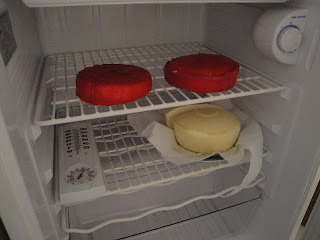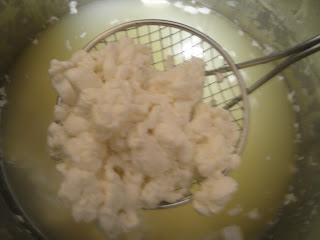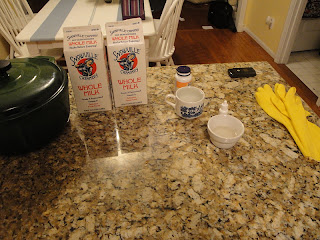So after making my first hard cheese,
Farmhouse Cheddar, I looked for a hard cheese I could make that did not need to take very long to age. For those who know me well, I have little patience and so it has been really hard for me not to cut open my cheddar and see how it tastes. So I found one. This is a Spanish Cheese and it is called Manchego. It is traditionally made from sheep milk but I used cow since I do not have access to sheep. I was quite excited to try it since I lived in Spain for two years and enjoyed several of the cheeses there.
First there are several types of Manchego. There is
Manchego Fresco (fresh)
which can be aged anywhere from a couple of days up to 2 weeks.
Manchego Curado (Cured) aged three to six months. And then there is
Manchego Viejo (old)
which is aged at least one year.
|
|
| Ingredients with my ever faithful cheese journal |
So first the ingredient list
- 2 Gallons 2% milk
- 1 packet mesopholic starter
- 1 packet thermophilic starter
- 1/2 tsp calcium chloride
- 1/2 tsp Rennett diluted in 1/4 cup water
- 2 lbs canning salt
- 1 gallon water
-I first added the milk and heated it to 86°F
-After reaching this temperature I turned off the heat and put in the calcium chloride mixed it up really well and then I put in both cultures. Then I let it set for 45 minutes off the heat (I was using a double boiler)
-Next I added the diluted rennet and stirred (checking the temperature and making sure it was staying at 86°F, when it dipped I put it back on the heat). I then let this set, covered, for 30 minutes.
 |
| Clean break of the curds |
-After getting a clean break I cut the curds in to 1/2 inch cubes, then let it set for 5 more minutes.
-Next came a new part for me and before I started I did not realize I had to sit there for 30 minutes stirring the curds with a whisk gently changing the 1/2 inch cubes into little rice size curds. For me it looked a lot like cottage cheese at first.
 |
| The curds while I stirred them |
|
 |
| The curds near the end of the 30 minutes |
|
-Now I heated the curds slowly to 104°F (increasing 2° every couple of minutes) stirring gently
-then let the curds set for 5 minutes.
-I then poured off the whey (keeping it to make whey ricotta out of it) and ladled the curds into a cheesecloth lined mold.
 |
| Pouring off the whey but still capturing any curds that sneak through |
 |
| The curds after pouring off most of the whey |
-Next I pressed the bricks with the same crude press I used last time using 1 brick for every 5 lbs of pressure I needed
-First 15 lbs for 15 minutes, then taking cheese out flip it over and then back into the press
-repeat this 3 times but on the third time use 35 lbs (7 bricks) for 6 hours.
 |
| Manchego in mold after being pressed |
 |
| Cheese out of mold, after being pressed |
-Next I created a salt brine solution by using 2 lbs of cheese and 1 gallon of water I soaked the cheese in this brine for 6 hours at 55°F
-After the 6 hours I cut the brick of cheese in half, so that I can eat one as a Fresco and hopefully the other as a Curado
-Now I coated both bricks of cheese (I estimate that each one was around 1lb so 2 lbs in total, but I need to get a food scale soon so I will now exactly) in olive oil.
For those who have been to Spain or know anything about them they use olive oil for everything, I was often told contradictory things that olive oil can do, for example if you have a dry scalp use olive oil, if you have dandruff use olive oil, if you want to gain weight use olive oil, if you want to lose weight use olive oil, etc... So in my mind using the olive oil is what make it very Spanish.
 |
| Me coating the Manchego in olive oil |
So that is it for this adventure, I am quite satisfied. I did have some troubles at the beginning keeping the water at 86°F it kept wanting to be a little higher. I will have to figure out a easy way of keeping the temperature steady. I am really excited to try this cheese in the next few days. We will see if I can wait till the weekend before I break into it. Now I just need to flip it every day and rub of any mold that grows with some salt water. Sometime soon I need to make some more cheddar because at work we will be having a chili cook-off and I want to bring my own cheese to put on top of it.
 |
| My cheese fridge in my basement. The ones on the top row is my Farmhouse Cheddar coated in red wax and my Manchego below that coated in olive oil. |



















































